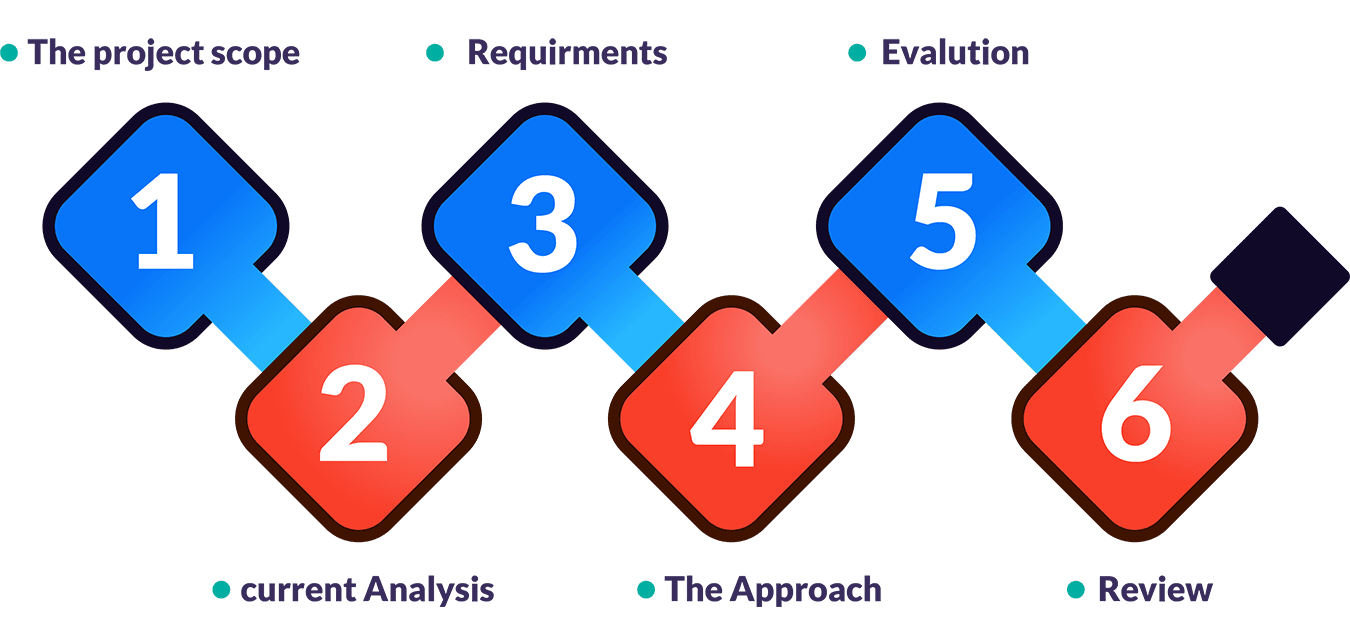
Feasibility Study
Feasibility study defines an opportunity or the problem which is under analysis looks at the current situation, defines the required, assess the alternatives and an agreed course of action. Activities for preparing feasibility study to apply to almost any type of project, be it a technological undertaking, procurement process or any other project. These are the parts that should be covered to any effective feasibility analysis. More ..

The project scope
This is the extent of coverage in a given project; it represents what is to be done as far as the undertaking is concerned. It defines the business problem which needs to be addressed, clearly defining the areas to be covered. It also defines the parts of the business which are directly or indirectly affected by the problem and how this is to be addressed. It identifies all the components of the project including all those who will be involved and the parts they will be played. A clearly defined scope is the foundation of the project, it helps in determining the cost, quality and the time it will take for the project to be undertaken. Projects which are started without a laid up scope end up with problems; they wander in and about the boundaries leading to poor deliverables. Any business intending to undertake a project should focus on having a clear scope, where all the project deliverables are identified, all the components are included and the areas to be covered are clearly articulated. With this, project implementers will have a clear understanding as far as boundaries are concerned, and will only concentrate on what is to be covered. Noah Matrix with its rich pool of project management experts will help business draw up a comprehensive project scope, ensuring that all that is needed to address a business problem is incorporated. With such measures in place, projects will be implemented successfully leading to effective solutions and an increase in productivity at a relatively lower cost.
Current Analysis
This is the assessment of the current situation; it helps in defining and understanding the current methods of execution such as product, system among others. With this type of analysis, sometimes you discover that there is nothing wrong with the current product or system. It could have been a misunderstanding or a case where only some minor or simple modifications are required to a major overhaul. The current analysis also includes the identification of the strengths and weaknesses of the current approach. Conducting a current analysis, in this case, saves the business a lot of resources. If for instance, this process was not done or was carried out shoddily, the business would have ended up wasting resources overhauling a system. This is not a prudent use of resources; it ends up tying them in unnecessary undertakings, something that can lead to failure. However, caution needs to be exercised when carrying out a current analysis, one should avoid the temptation of stopping or correcting any problems found in the system at the given time. One should simply document, otherwise, a lot of time may be spent at this stage, a situation that is referred to as analysis paralysis.
Requirements
Requirements and requirements definition varies from the type of product or project in consideration. For instance, the requirement for an information system project will be different from an infrastructural undertaking such as a new plant. Each will have different characteristics and properties and therefore ought to be treated differently. How requirement definition is undertaking will greatly influence how the project will be implemented and its overall success. Therefore, this must be done right from the onset.
The Approach
This is the suggested solution or course action to fulfill or satisfy the requirements. This stage involves considering alternatives and giving a clear explanation or justification as to why a given solution was chosen. For design projects, this is where renderings or rough designs are developed to determine their viability. Also, existing structures, as well as commercial alternatives, are looked at. At this point, one considers what other courses of action would be viable, for instance, one question that is asked is whether it makes sense to buy or build? The overriding considerations at this stage are:
- Will the suggested approach help in meeting the requirements?
- Is this a viable or practical solution?
It is important to carry out a comprehensive and thorough analysis to perform the subsequent steps. The results that will be derived here, just like in other faces will have ramifications on the whole process. So it important that whatever is done here, be done satisfactorily.
Evaluation
This is the stage where the cost-effectiveness of a solution is examined. The evaluation process starts with the analysis of the estimated cost of the undertaking. Additionally, the alternatives are also scrutinized to give the study a greater focus where economic comparisons are made. The purpose of analyzing the alternatives is to make sure that there is a clear understanding as far as the best option is considered. It is not always prudent to rush on the first recommended product or project; you need to look at other solutions that would have been considered. This is to help you understand whether there was an alternative solution that would have yielded the same or better results at a lower cost. After establishing the total cost of the project, a cost and evaluation summary is availed, it should be comprehensive addressing all the project aspect. The evaluation process should also use tools such as cost-benefit analysis, returns on investment among others.
Review
This is the stage where all the preceding components are assembled and a formal review is undertaken. The process ought to be inclusive, where all the parties are involved. This exercise serves several purposes including ascertaining whether the feasibility study was carried out accurately and thoroughly and also as an aid to decision making. It is at this level that a decision on whether to continue with the project is made. The decision will largely be influenced by the results of the review exercise. If there is a convincing narrative to continue with or reject the project, this is the stage when that will be decided. Whatever decision carries the day, there should be a justification. If the review recommends a continuation with the project, all the involved parties must sign the document as an express commitment and acceptance of the undertaking. Signing may be just a formality but it carries more weight especially when it comes to later stages of project implementation.
A feasibility study should be seen as a thought process rather than a bureaucratic exercise. It should represent a common approach to the planning process. Every project should be subjected to this exercise to ensure that what is to be undertaken is viable in different aspects and will help in meeting the objectives of a business enterprise.
